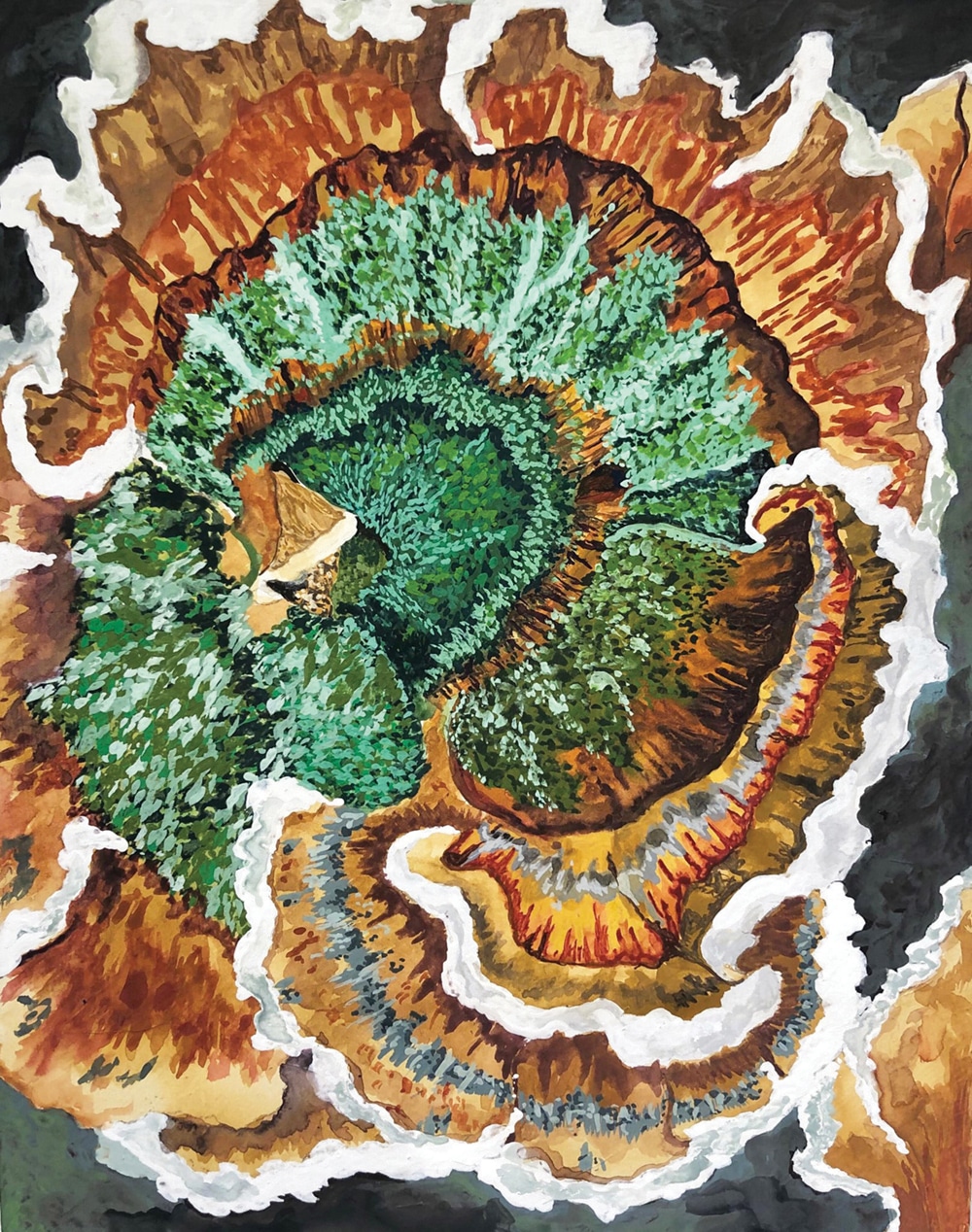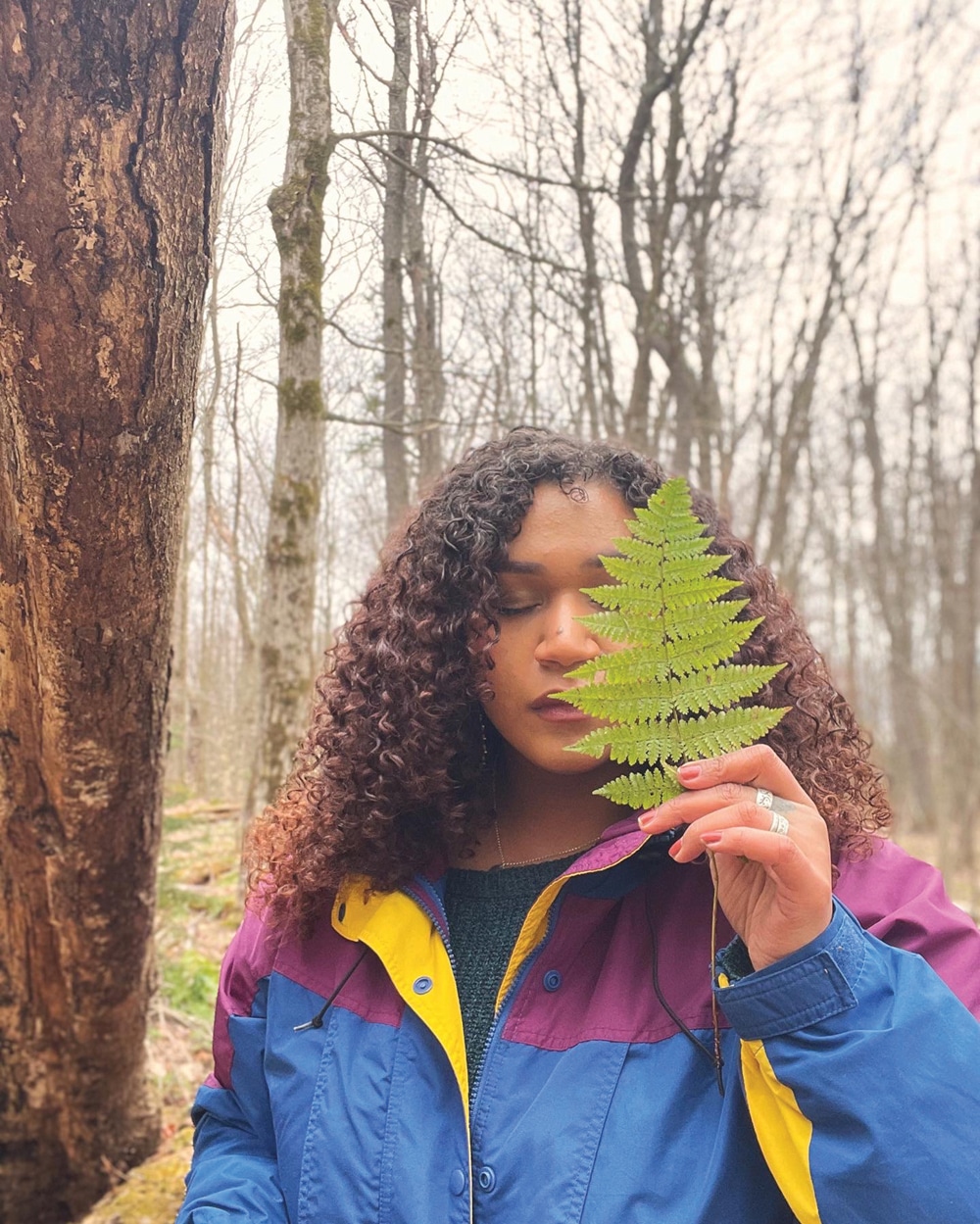Growing up in northern Vermont, Dominique Butler spent a lot of time in the woods learning to track wildlife, fish, camp, and survive in the wilderness. It is those early and formative memories that form the foundation of her art today.
With incredible attention to structure and elements, from intricate patterns to the slightest change in colors found in nature, Dominique Butler’s paintings invite the audience to immerse themselves in a world of microscopic beauty. “I learned how to observe nature at a very slow pace and how to pay attention to detail,” Butler said. “I’ve carried that fascination and passion for being in nature as I enter adulthood. I’ve also learned how to articulate my curiosity and questioning as to why there isn’t much representation of Black people in nature.”
It is that curiosity in artmaking that causes it to play a central part in society, illuminating issues, telling stories, expressing emotion, and fostering community. For Butler, the creativity and ability to make art is something found inside each of us, even if it doesn’t take the form of a painting, drawing, or sculpture.
Artist is more than a job title or line on a resume. “Even if no one wanted to see or purchase my work, I’d still be painting,” Butler said. “It’s such an intimate and personal thing, so at the end of the day, I create these works of art for me and my enjoyment. Painting is the one thing that makes complete sense to me. In no other subject or field am I as confident and comfortable than how I am with art. I wouldn’t be me without it.”

The Technique
Now based in Baltimore, Md., Butler continues to find inspiration for her pieces in the world around her. Patapsco Valley State Park, about a 30-minute drive outside of the city with some of the first trails she explored when she moved to the area, is one of Butler’s favorite places for walks and hikes in nature.
While outside, she takes photos with her phone of things that catch her eye, like a section of moss with a nice shape or a vibrant shade of green. “I have hundreds of these photos that just live on my phone and many of them I won’t look at again for months at a time,” Butler said. “When I’m ready to start a piece I’ll go through some of these pictures, select a few, and then start cropping or rotating them.” One of her favorite times to go outside is right after it rains when the colors are more saturated and intense.
Working from the images, Butler then sketches out her design and layers the piece with gouache and acrylic paints. With so many different types of materials, from bark and lichen to mushroom tops and leaves, each piece delves into the lines, colors, and shapes that can be found when you take the time to look closer. “I like challenging myself and attempt to capture the contrast of the various textures within my pieces,” Butler said.
In between projects or when the creativity is harder to come by, Butler will take a step back from her work to sketch and read. “Doing this lets me come back to a painting with a fresh start,” she said. Instead of focusing on the tiniest details, she will zoom out to work on a human portrait or animal anatomy study to flex her drawing skills and push through artist’s block.

Playing with Scale
From tiny four-inch canvases to two-foot self-portraits, size plays an important role in how Butler presents her work. Painting on a smaller scale, like her mushroom and river rock pieces, helps Butler to slow down and pay attention to what she is really trying to capture. “It’s meditative in a way,” she said. “I get into almost a trance-like state. I’ll spend hours not moving, completely focused on getting every small detail I can muster.”
But the size also plays a dual role in pulling the audience into the scene. “I’m making the viewer stop, take a moment, and lean in to see my painting,” Butler said. “Physically making them get as close as possible. I like that intimacy.” A piece that size, small enough to be held in the palm of your hands, invites a more personal relationship with the object.
In contrast with her tiny canvases, Butler is currently working on a series of large portraits of Black National Park Rangers, including Shelton Johnson and Betty Reid Soskin, and is spending some time researching the Black Buffalo Soldiers of Yosemite Park. The large canvases are a way of physically taking up space in an industry and places where all too often people of color feel unwelcome and harassed. “I would love for my work to help prompt white outdoors people to think about how they can use their privilege to make green spaces safer and more accessible to Black individuals and people of color,” Butler said.
You can find more of Butler’s work at DominqueButlerArt.com or on Instagram @_dom_butler.
Cover photo: “Forest and Stream” by Dominique Butler. Image courtesy of the artist








